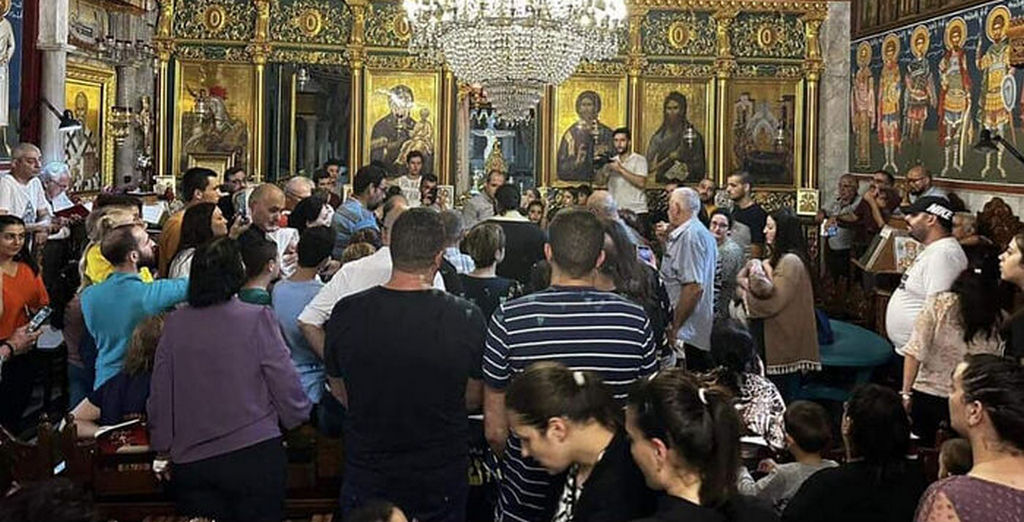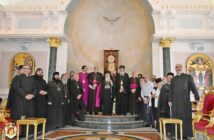Source: Public Orthodoxy
Michael G. Azar
Associate Professor of Theology/Religious Studies at the University of Scranton
In his fight against those in Gaza whom he called “human animals,” the Israeli defense minister on October 8 vowed to act “accordingly” by cutting off fuel, food, water, and electricity to the impoverished strip of land. With this explicit policy of collective punishment (which has gotten even more collective and punishing in the last month), residential neighborhoods and marketplaces became immediate targets. Israel’s military dropped 6,000 bombs in the first six days of the war with “damage, not accuracy” as its goal.
In those first few days, the neighborhood surrounding the Greek Orthodox Church of St. Porphyrios in Gaza City (named after the fifth-century bishop of Gaza) felt the intense bombardment that the “children of light” were bringing against the “children of darkness” (as Israel’s prime minister eventually described the scenario). Many Christian families lost or left for fear of losing their homes in these bombings and moved into the church, along with several others (Muslims included) who believed the church would be a safer place than the residential blocks.
At first, around 150 people moved onto the property of the church, which was founded over 1,500 years ago. Within a week, the population nearly tripled to over 400 people spread across the property’s three main buildings. Access to food, water, and electricity quickly became difficult, as did other basic needs.

By the end of the first week of the bombardment, the Israeli military directed the people in Gaza City (around 1.1 million people) to move south within 24 hours. This evacuation order explicitly demanded that people leave “public and known shelters” to go south. Some at St. Porphyrios decided to heed the call, though Hamas directed otherwise, and many of those who started to move from the north were then killed in an Israeli airstrike. Others, concerned about a similar fate or for other reasons, stayed behind. Besides the immediate threat to life, many feared that they would not be allowed to return to Gaza City if they left, and thus would be the end of the Christian presence (the fears are justified). After that first week, several people sheltering at St. Porphyrios posted their wills and pleas for forgiveness on social media, not knowing when they might lose either their internet connection or their lives.
As the days went on, airstrikes landed closer and closer to the church property, with the accompanying noise and shaking walls becoming ever more regular.

The names of those who died at the Church of St. Porphyrios on October 19, 2023
Nonetheless, Archbishop Alexios, who oversees the community in Gaza, assured his people that he would remain with them: “As long as there is at least one Christian in the territory of Gaza, I will not go anywhere, because I can be a hope for them, so I will stay in the province that believes in me. If I die, I will have a dignified death as my destiny.”
On Tuesday, October 17, ten days after the bombing campaign had begun, Al-Ahli Hospital was hit by a missile. While world powers and pundits disputed the source of the missile, it mattered little for the people of St. Porphyrios, as it was terrifyingly close, shaking the church buildings. People had to wear masks to cover up the smell. Two days later, on October 19, the church property itself was hit by an Israeli airstrike (which officials later claimed was directed at a nearby Hamas “command and control” center). The strike caused one of the buildings to collapse, killing many inside. Those who died were primarily from three families who were sheltering together, ranging from 12 months old to the elderly. One of these families was wiped out entirely. For a community as small as this, the loss is especially significant. The Patriarchate of Jerusalem subsequently called the bombing a “war crime that [could]not be ignored”; condemned what it called Israel’s “targeting [of]humanitarian institutions,” and vowed to remain “committed to fulfilling its religious and moral duty in providing assistance, support, and refuge to those in need.” Meanwhile, church officials, including Archbishop Alexios, worked to ensure that the church’s location was known well and contacted several embassies to put pressure on Israel for a ceasefire. But the international clout of Orthodox Christians in the Holy Land—though they are historically the most populous Christian tradition in the region—has historically paled in comparison to others with more influence in Western Europe and North America. Thus, the calls of church officials went unheeded. The funeral for the victims at St. Porphyrios was held the following day—and for the first time elicited some international coverage of the community, whose experiences thus far had largely escaped media attention.
In the days following the airstrike, a few families moved to Gaza’s Catholic Church of the Holy Family, both because they believed it to be safer and because it had more room. But many soon returned, and so St. Porphyrios remains with around 300–350 people in its care. (Though not the focus here, Holy Family is likewise sheltering hundreds of people and its situation is no less dire than that of St. Porphyrios.)

The week after the bombing of St. Porphyrios saw the greatest number of daily strikes and accompanying deaths since the war had begun, as Israel was preparing the territory for a ground invasion. Once again, the Israeli military issued a directive for people in Gaza City to go south. However, unlike the previous order, this one warned that anyone who remained “may be identified as a partner in a terrorist organization.” Simply by remaining at St. Porphyrios, those sheltering risked being classified as terrorists. Such made frighteningly real the President of Israel’s explicit claim that all civilians of Gaza are culpable for the actions of Hamas.
In light of these concerns, the Church of St. Porphyrios conducted a “mass baptism” of nine children on Saturday, October 28, amid the first major communications blackout that Israel imposed on Gaza, while increasing its airstrikes in the area to levels not seen previously.
On Sunday, October 29, the Israeli military warned those sheltering at the Orthodox cultural center in the west of Gaza City (around 1,000–1,500 people) to leave the property. Two days later, on the morning of October 31, Israel’s military destroyed the state-of-the-art building in an airstrike. Having seen yet another one of its properties targeted, the Patriarchate of Jerusalem issued another scathing statement: This “unjustified attack on one of the pillars of culture and social services in Gaza,” the patriarchate said, represented “a stark embodiment of Israel’s unwarranted determination to destroy the civil infrastructure and social service centers, as well as shelters for civilians trapped in the besieged enclave.” Accordingly, it called once again for “an immediate and comprehensive ceasefire in the Gaza Strip.”
Such a ceasefire has not happened in the days since, and now, as Israel’s military, in its fight against Hamas, has entered Gaza and has cut off the north (Gaza City) from the south, the situation in the north has gotten even more dire than previously.
The Christian population of Gaza did not choose the Hamas government—indeed, given that over seventy percent of the current population were children or not yet born when Hamas came to power in 2005, nor did most of Gaza’s population. Hamas in the years since has solidified its rule of Gaza, refusing to hold any subsequent elections. Regularly bolstered by its own militant determination, external funding, and the Israeli prime minister’s previous policy of keeping the Islamist group in power in order to preclude any possibility of an independent Palestinian state, it remains the government of Gaza (at least at time of writing).
As with all populations everywhere, no matter the country, Gaza’s people have had to bear with the consequences of their government’s policies and actions whether they support those policies and actions or not. But one should be clear: While Israel’s ongoing bombardment and invasion of Gaza is most immediately the result of Hamas’s attack on October 7, it is callous, duplicitous, and pernicious for leaders and scholars elsewhere—especially Christian leaders—to argue that “responsibility” for the deaths of “innocent people” and the “current escalation of violence” lies “solely with Hamas” (as a German Jewish-Christian working group stated) or that it is exclusively “Hamas” who is bringing “suffering” on the “civilian population of Gaza” (as an international group of biblical scholars claimed). Governments of sovereign states bear the responsibility for what those governments choose to do. Israel’s ongoing policy in Gaza is no exception.
The previous bombardment of Gaza in 2014 served to decrease the Christian population there (of which Orthodox Christians make up the vast majority) by about 25% to the roughly 1,000 Christians who lived there before October 7. It is hard to imagine that the effect of the current war will be anything less than catastrophic for Gaza’s few remaining Christians.
ABOUT AUTHOR
Public Orthodoxy seeks to promote conversation by providing a forum for diverse perspectives on contemporary issues related to Orthodox Christianity. The positions expressed in this essay are solely the author’s and do not necessarily represent the views of the editors or the Orthodox Christian Studies Center.




![Suprasl: Celebrate the World Day of Orthodox Youth [February 2nd (15th old style)]](https://ocl.org/wp-content/uploads/2024/01/SUPRASL-LOGO-214x140.jpg)
